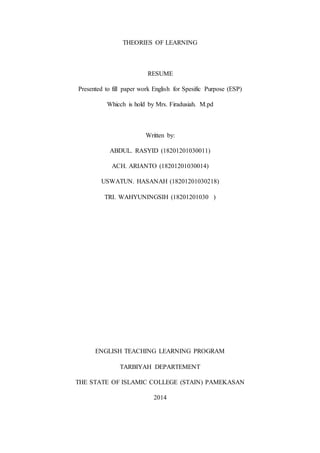
Theories of learning
- 1. THEORIES OF LEARNING RESUME Presented to fill paper work English for Spesific Purpose (ESP) Whicch is hold by Mrs. Firadusiah. M.pd Written by: ABDUL. RASYID (18201201030011) ACH. ARIANTO (18201201030014) USWATUN. HASANAH (18201201030218) TRI. WAHYUNINGSIH (18201201030 ) ENGLISH TEACHING LEARNING PROGRAM TARBIYAH DEPARTEMENT THE STATE OF ISLAMIC COLLEGE (STAIN) PAMEKASAN 2014
- 2. THEORIES OF LEARNING I. EXPLANATION Theories of learning is the conceptual framework describing how information is absorbbed, processed, and retained during the learning. This is about how the learners process the information in which they have took. Learners may have their style in learning process but they have a same destinition in order to understanding what they learnt. Learning laguage means the understanding of structure and the processes of the mind. Unfortunately, we know about the the people thinking. Althought, when people try improve the techniques, methods and content of language teaching, they have to try and find what they will do in the classroom atmosphere. Develoments in leaening theory have followed a simmilar pattern to those in language description, and ech has had some effect on the other. When Looking about the importance of each for language teaching, it is best to consider the theories relating to language and learning separately. In twentieth century there was no coherent theory of learning available to language teacher, until psyhcology had been established as respectable subject of scientific enquiry in the early twentieth century. There are five main stages have identified of development which are commomnly known as : Behaviorism, Mentalism, Cognitive Code, Affective Factor, and Learning Aquisation. II. KINDS OF MAIN STAGES OF DEVELOPMENT A. Behaviorism. This is about the mechanical process of habit formation and brings product of frequent reinfocement or stimulus – response sequence. This methods, showing the learning process as a change in behavior, and will arrange the environment to elicit desire responses through such devises as behevioral objectives. Pattern of this methods are :
- 3. Never translate New language should always be dealt with in the sequence : hear, speak, read, write. Frequent repetation is essential to effective learning. All errors must be immeditely corrected. B. Mentalism. According chomsky’s definition in Tom Huchinson and Alan Waters said that Thinking must be rule-governed • A finite • Fairly small • Set of rules enables the mind to deal with the potentially infinite range of experience it may encounter. The mind in other wodrs, does not just respon to thestimilus,it use the individual stimuli in order to find the underlying pattern or sistem. Unfortunately, learning is consist not of forming habits, but acquiring rules. C. Cognitive Code. The cognitive code takes the learner to be an active procesor of information. Therefore, the learner takes process actively to make sense of data, and learning can be saidto have taken place when the learner has managed to impose some short of meaningful interpretation or pattern on the data. In ESP project has concern on making the student aware of their reading strategies. So that tey can aplpy them on understanding to understanding texts in foreign language. D. Affective Factor. The cognitive theory has explained thet learners wiil learn when they actively think about something. In this case learners try to combinethe emotinal factor and cognitive theory in order to take success or otherwise of a language learning experience. That is the reason why the important elements in the development of ESP is motivation. There are two influential of motivation in language learning. They are : Instrumental motivation. This is reflection of external needs. It means that learner learn the language does not becase they want to, but they may be need some aims. Likes speaker, examanaion etc. Integrative motivation. In this case leaners learn the language because the they use it as communicative speech to the otehers.
- 4. In ESP, as much as any good teaching, needs to be intrinsically motivating. It should satisfy their need as a learners as well as their needs as potential target users of the language. E. Learning and Acquisition. In this case learning is seen as conscious process, while aquisition proceeds unconsciously. In this section the two terms interchangeably. It means that when people learning language, automaticaly they will aquire it in unconsciously. That is why the both terms are interchangeably. In the ESP we also will know about the a Model for Learning. It presents the mind as a network conditions, rather like a road map. There are some various of mind way when the learners showing an idea. The mind of the learner like a development agency. It brings a settlement into a netwok and so develope his potential. To reach this, communication links must be established. Therefore, communication network can proceeds from existing links. III. CONCLUSION To sum up, learning theories have their style in used. On the other hand, leaners may have their distinguish in understanding learning language. Teachers have to take an electic approach in order to teach learners. It is important to make good understanding process of the students. In ESP, we known a cognitive, affective and others aspecs to learning, and each can be a resource to the ESP pratisioner.
- 5. REFFERENCES Hutchinson, Tom and Water Alan. 1987. English Specific Purpose. Great Britain : Scotprint Ltd. Hill. F. Winfred. 2009. Alih bahaasa Khosim. M. Theories Of Learning. Bandung : Nusa Media. www. Theoris of Learning. com